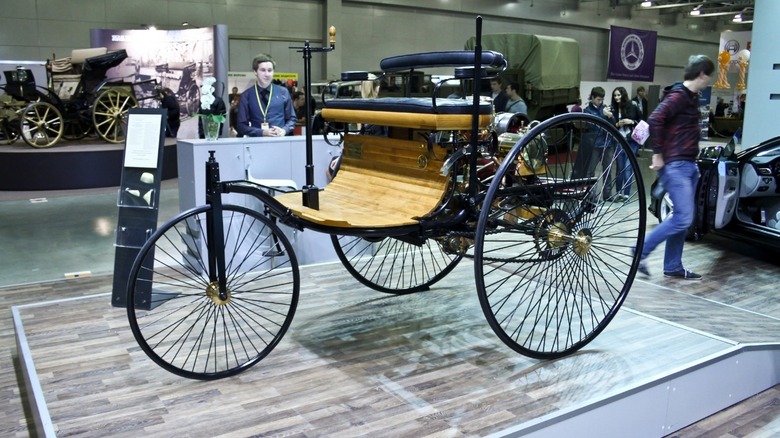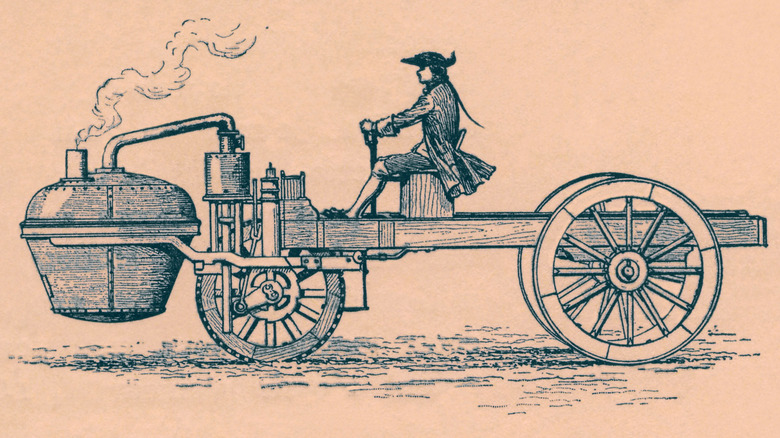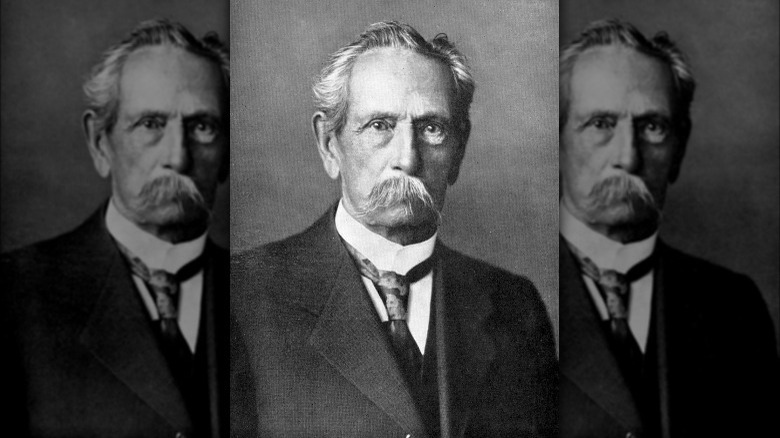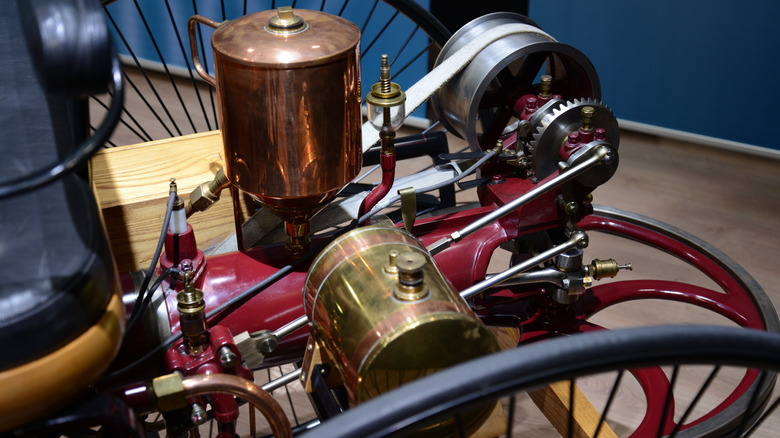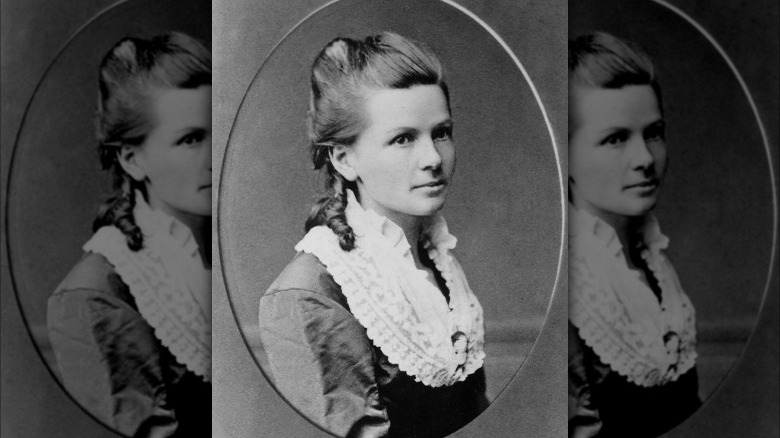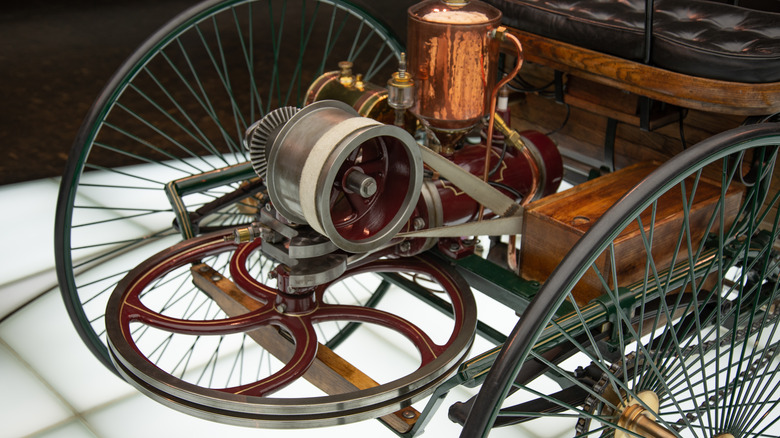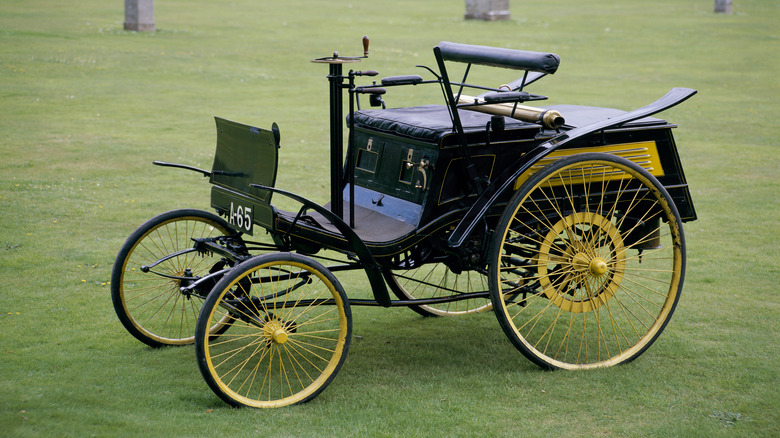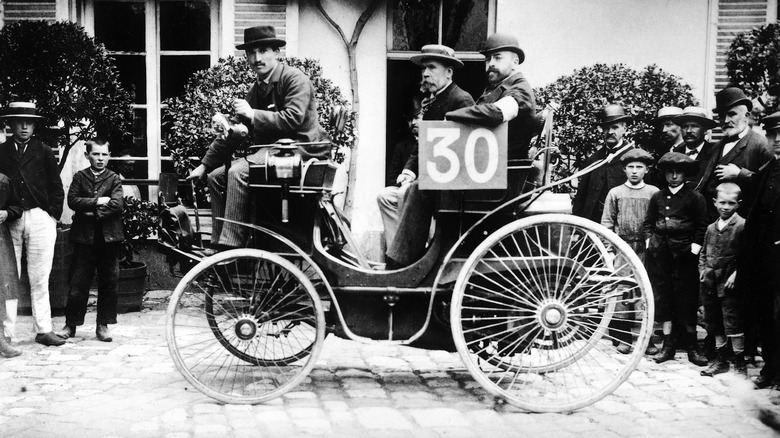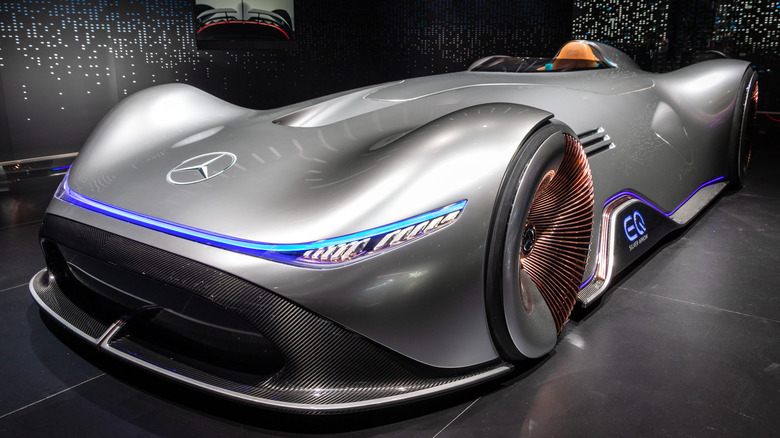Everything You Should Know About The First Car Ever Invented
It can be hard to put into words just how influential the automobile has been on society, contributing to advancements in transportation, industry, and even pop culture. While the train and steamship offered rapid movement of people unheard of in the century before, the automobile did the same, but on an individual basis. The advancements in engineering and manufacturing through the Industrial Revolution paved the way for a self-powered carriage to be built. The internal combustion engine was first created in 1859 and found its first usage mostly in stationary industrial applications. However, it sparked ideas in clever men who would begin work to create self-propelled machines using these new engines.
The first gentleman to successfully create an application of the internal combustion engine for a self-propelled vehicle was Carl Benz. He mounted a single-cylinder gasoline-powered engine on a custom-made frame of his own creation, building the first car. It had three wheels and was steered by a tiller. It was not fast, nor was it flashy, but it worked. It also did not take long for his idea to catch on as multiple companies began sprouting up around Europe and America building their own version of horseless carriages, with dozens of companies existing by the 1890s. It is likely that had Benz not thought of this idea, someone else would have. Regardless, the first car was the invention of Carl Benz, and here is everything you should know about it.
Establishing the first car
Some controversy exists over whether the Patent Motorwagen was the first car. Others had been toying with steam engines applied to road transportation, as well as in farm equipment, to varying degrees of success. But steam engines are large and heavy, and require huge amounts of fuel and water to run. Early internal combustion engines were run on gas — not gasoline — that required being connected to municipal gas lines. Huge hurdles had to be jumped before a viable independently powered carriage would work.
In 1769, according to Autoweek, Nicolas-Joseph Cugnot did create a lumbering and slow three-wheeled contraption powered by steam that some consider the first car. However, it would be hard to consider it successful, as it was not very practical and also ended up being involved in the first-ever car accident. Another steam-powered contraption was the American Oruktor Amphibolos amphibious digger/dredger, but funding never materialized, and it did not make it past the prototype stage.
If the criteria qualifying the first car considers that it worked beyond a prototype, carried passengers, and was powered by gasoline, then the Carl Benz vehicle is it.
Carl Benz, father of the automobile
Germany was at the center of the Industrial Revolution in Europe, and some of the greatest advancements in engineering sprang forth from the Land of Poets and Thinkers. Growing up poor with a deceased father, Benz's education was highly important and he excelled in his studies, which earned him a degree in mechanical engineering in 1864.
After working a variety of jobs with little satisfaction at construction and engineering firms, he chose to set up an iron foundry and sheet metal workshop on his own. With help from a partner, he used his business to develop a range of inventions for which he received patents. Many of these designs would go on to be integral parts of the automobile, including carburetors, ignition systems, and a clutch. He also had a close relationship with his wife, Bertha, who would also be a partner in his business when he was able to push his unreliable partner out (via American Society of Mechanical Engineers).
Creation of the first car
With Benz's expertise in engineering and experience in manufacturing, along with his patents related to internal combustion engines, he was well-suited to invent a new kind of vehicle. Benz also happened to be living in a time when advances in engineering were happening at a rapid pace, setting the stage for this and other inventions with wide-ranging repercussions. The machine business he started, which later saw his wife as a full legal partner, developed a stationary gasoline engine that would see success almost immediately. After having some trouble selling the engines he was making, Benz sought investors who would inject capital into the company, setting up a corporation at the time.
His engines relied on gas from city mains, so he developed a way to ignite gasoline with a spark plug of his own design to create an engine that could be portable. Benz and his partners were avid bicyclists and leaned on that technology in creating the frame for a new self-propelled carriage, and were guaranteed a patent in 1887. A three-wheel design was chosen because it would be less complicated to build, and easy to steer. After much trial and error, including broken chains and a short drive into a brick wall, a working prototype was born (via Heacock Classic).
The first motorcar arrives
Carl Benz's wife, Bertha, without the knowledge of her husband, took a completed Motorwagen on a "test drive" with her son from Mannheim to Pforzheim, a journey of about 50 miles. Along the way, she ran out of fuel and had to find a replacement supply. With a lack of filling stations at that time, she found suitable fuel at an apothecary in Wiesloch, effectively making it the first gas station in the world, according to Atlas Obscura. What she found was an industrial solvent called ligroin that worked well enough for the 65-mile trip.
Before Bertha's trip, Carl Benz was having trouble finding buyers for his new Motorwagen. But after making the historic journey through the winding roads of Germany, stopping in various small villages along the way, publicity grew and it created a buzz that resulted in sales. Word of the trip spread so much that it was picked up by the press, providing invaluable publicity for the fledgling company.
Design and construction of the Patent Motorwagen
A great deal of the construction for the Patent Motorwagen was inspired by bicycles of the day. It rode on a tube-steel chassis, and its wheels were made with steel rims and wires with solid-rubber tires. The steering tiller transferred direction to the front wheel through a primitive rack and pinion gear system, and the rear wheels were driven via chain. Other components, such as the seat and collapsible roof, were fashioned similarly to those on contemporary horse-drawn carriages (via Garage Dreams).
The engine was a single-cylinder four-stroke with a displacement of 954cc. It produced just ⅔ horsepower. At the end was a pulley to drive a belt that would act as transmission and clutch, with the final drive connected by chain. There also sat a large flywheel underneath that doubled as the starter: One would grab the flywheel, give it a hard spin, and fire it up to a steady rhythm of chugs and hisses from the combustion and intake strokes. The engine was water-cooled, but had no radiator — water was fed from a tank in a full lossless coolant design (via SciHi). Once the water tank emptied, it had to be refilled to prevent overheating. The only controls consisted of the steering tiller and a lever that served as both accelerator and brake.
It was not fast and required near-constant adjustments, but it worked and could be kept running, something that could not be said of other inventions of the day. In reality, a horse-drawn carriage would have been more practical and useful, but the novelty of the Motorwagen made it a valuable curiosity.
Benz & Cie manufacturing
Carl Benz built his prototype and used the process to continue to develop and refine his machine. For example, while running the engine of the first Motorwagen, he had one of his sons holding a canister of fuel to feed the carburetor when Benz realized it needed a fuel tank — his previous engines ran on gas from city mains. The vehicle Bertha took on her now infamous drive was model number three and she, being an integral part of Carl's work as well as being clever and intelligent, learned a few things to help to improve future models.
After Bertha's drive, the publicity followed with orders for the car. As each one was hand-built, they took a good deal of time to make. They eventually made 25 cars before looking for ways to improve them. The Patent Motorwagen evolved into the Benz Patent Motor Car Velocipede, becoming the world's first production car, selling 1,200 units in total, according to Benz's successor company, Mercedes-Benz.
Impact on society
The degree to which this car changed society is hard to quantify. While others were working on similar vehicles at the same time, Benz made it to the finish line first. His Velocipede went on to sell many units and by 1894, a Benz car was competing in the first organized auto race, the Paris-Rouen, winning fifth place, per Mercedes-Benz. Coincidentally, the Benz car was bested by a Daimler, the company that would go on to join Benz to form the current manufacturer, and both of them lost to a steam-powered DeDion-Bouton.
While cars would remain mostly toys of the wealthy for some time, when the technology was finally made affordable for the masses, the whole world changed. While mass transit made the Industrial Revolution possible, the ability for individual free movement gave rise to a society of technological revolutions, with advances happening on faster and larger scales. It would probably be correct to say that the modern world, in many ways, revolves around the car.
Legacy of Carl Benz
The company founded by Carl Benz is still around today and is well-known for making some of the finest cars on Earth. The original car paved the way for hundreds of manufacturers to come and go, and the successor company has been responsible for some of the most consequential developments of auto manufacturing, including the multi-valve engine, superchargers, the crumple zone, anti-lock braking, crash test programs, and so much more. Mercedes has long been a leader in racing, building opulent and extravagant automobiles, and safety innovation. It is a symbol of German industry, and the city of Stuttgart is known as the "cradle of the automobile," a source of pride for its residents and the people of Germany (via Goethe-Institut).
Today, a Mercedes-Benz car is a sought-after prize and icon of success. The desirability of these cars is not without cause; they are truly enjoyable and capable vehicles that many feel are worth the premium price. Furthermore, many models represent some of the fastest and best-handling driving cars ever built. Future development and concept cars from the company offer a glimpse of what is to come, with fascinating new features and a world of electric mobility seemingly a galaxy away from the original three-wheeled carriage of the Victorian era. However, no matter what changes continue to happen within the automotive industry, it is apparent that the Mercedes-Benz brand will be a part of it for decades, if not centuries, to come.
